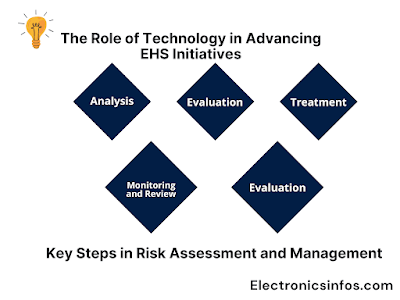The Role of Technology in Advancing EHS Initiatives
The Role of Technology is how changing the way companies handle EHS (Environment, Health, and Safety) practices. It's making things safer, more sustainable, and more efficient. In today's world, where people are more concerned about the environment and staying safe at work, companies are using technology to support their efforts to be more eco-friendly and take care of their employees. For This purpose, we discuss parameters that define how technology impacts Advanced EHS((Environment, Health, and Safety).
 |
| Role of Technology in Advancing EHS |
Data Collection and Monitoring
Data Collection and Monitoring means gathering information and keeping a close watch on different aspects of Environment, Health, and Safety (EHS) in real time. We use technology, like sensors and devices, to track things like the environment, our health, and safety conditions. The idea is to have accurate and up-to-date information to understand how things are going in terms of safety and sustainability at work. This helps us identify any problems and make smart decisions to keep the workplace safe.
How to Real-time Tracking of EHS Metrics?
The Internet of Things (IoT) has made it possible to gather real-time data from various sensors and devices placed throughout workplaces and production facilities. This data includes information on air quality, temperature, equipment performance, and more. Real-time monitoring allows organizations to detect potential hazards immediately, reducing response times in emergency situations. Here's how the process works
- Installation of Sensors
- Continuous Monitoring
- Data Transmission
- Analysis of Metric
- Automated Alerts
- Reporting and Documentation
Risk Assessment and Management
Technology plays a crucial role in enhancing "Risk Assessment and Management" by providing data in several steps.
- Data Collection
- Data Analysis
- Risk Identification
- Data Visualization
- Decision Support Systems
- Communication and Collaboration
- Automation of Routine Tasks
- Continuous Monitoring
- Feedback Loops
Key Steps in Risk Assessment and Management
Training and Education
Training and education play vital roles in advanced training and education.
- Advanced Training
- Specialized Skills
- Hands-on Experience
- Continuous Learning
- Professional Development
- Communication and Reporting
- Efficient Safety Communication
- Automation in Incident Reporting
The Evolution of EHS Technology
EHS (Environment, Health, and Safety) has progressed significantly from using paper records and manual checks for following rules. Nowadays, technology allows organizations to handle EHS programs very precisely and effectively.
5 Best Outdoor Surge Protectors
Predictive Analytics
Advanced data analytics tools enable organizations to predict safety and environmental risks before they escalate. By analyzing historical data, patterns, and trends, EHS professionals can take proactive measures to prevent accidents, reduce emissions, and optimize resource usage.
Digital EHS Management Systems
Gone are the days of cumbersome spreadsheets and filing cabinets. Digital EHS management systems provide a centralized platform for tracking compliance, incident reports, training records, and safety documentation. This not only streamlines administrative tasks but also ensures that critical information is readily accessible to all stakeholders.
Wearable Technology
Wearable devices equipped with sensors can monitor workers' vital signs and exposure to environmental factors. This data helps in identifying early signs of stress, fatigue, or exposure to harmful substances, allowing for timely interventions to protect employee health.
Mobile Apps
Mobile applications empower employees to report incidents, hazards, and near misses in real-time, directly from their smartphones. This encourages a culture of reporting and ensures that potential issues are addressed promptly.
Benefits of Technological Advancements in EHS
- Enhanced Safety
- Regulatory Compliance
- Cost Savings
- Sustainability
- Employee Engagement
Enhanced Safety
Real-time monitoring and predictive analytics enable organizations to identify potential hazards and take immediate action to prevent accidents and injuries, ensuring the safety of employees and the environment.
Surge Protector Vs Power Strips
Regulatory Compliance
Digital EHS management systems simplify compliance tracking and reporting, reducing the risk of regulatory fines and penalties.
Cost Savings
Proactive risk management and optimized resource usage lead to cost savings in terms of reduced accidents, fines, and operational efficiencies.
Sustainability
Technology helps organizations minimize their environmental footprint by monitoring and reducing emissions, energy consumption, and waste generation.
Employee Engagement
Wearable technology and mobile apps promote employee engagement in safety initiatives, making workers active participants in EHS programs.
Future Trends in EHS Technology
As technology continues to advance, EHS initiatives will evolve as well. Look out for trends like
- Artificial Intelligence (AI) for predictive maintenance and risk assessment.
- Augmented Reality (AR) for immersive safety training.
- Blockchain for secure and transparent EHS data management.
Conclusion
Technology is undeniably a game-changer in the world of EHS. By harnessing the power of IoT, analytics, and digital platforms, organizations can create safer, more sustainable workplaces while ensuring compliance with regulatory requirements. Embracing these technological advancements is not just a choice; it's a necessity for organizations committed to the well-being of their employees and the environment. In the fast-paced digital age, technology is the driving force behind the future of EHS.


-Electronicsinfos.png)
.png)


0 Comments
please do not insert spam links